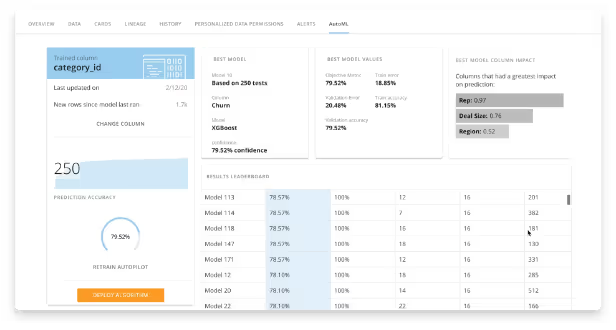
Saved 100s of hours of manual processes when predicting game viewership when using Domo’s automated dataflow engine.

Machine learning is a branch on the data science family tree. It uses data and algorithms to imitate the way that human beings learn. Through machine learning, algorithms are trained to make classifications and predictions and uncover key insights. In short, the goal of machine learning is to get computers to learn and act like humans do, eventually enabling computers to continually learn autonomously, without being programmed or relying on human intervention.
Data science is a large tree with many branches. It can be easy to get caught up in different terminologies and confuse their definitions. Aspects of machine learning may seem similar to data mining and deep learning, but there are distinct differences.
Machine learning focuses on understanding the structure of the data. Instead of testing a theory against the data, machine learning tests its findings on new data to see if the same rules hold true. It employs a more iterative approach that can be easily automated.
The goal of data mining is to extract insights from data sets. The data mining process may employ machine learning tools along with statistical algorithms, text analytics, time series analysis, and more to identify new data patterns.
Deep learning combines the power of computing with neural networks to learn complex patterns in large data sets. You may hear deep learning described as the next level of machine learning, but, in reality, it is more of a sub-field.
Insights from machine learning can improve business intelligence and help organizations make data-driven decisions. With machine learning, organizations can quickly automate processes and analyze more complex data faster than before. It can help businesses identify opportunities for growth and profit as well as identify previously unnoticed risks.
As the volume and variety of data that organizations collect grows, machine learning tools can offer a faster, more powerful, and more affordable way to learn from and apply data.

There are hundreds of new machine learning algorithms published each day, but a machine learning algorithm’s learning system contains the same general components:
While there are countless machine learning algorithms, they are often sorted into four main categories.
Supervised machine learning algorithms. These algorithms receive a set of inputs and the correct outputs. It learns by comparing its own output with those correct outputs to identify any errors. When the algorithm finds errors, it modifies its model. These types of algorithms are used in situations where historical data is likely to predict future events. Examples could include detecting fraudulent financial transactions or identifying spam in your inbox.
Unsupervised machine learning algorithms. These algorithms aren’t told what the correct answer is. Instead, the algorithm has to explore the data, find structure and patterns, and figure out what is being shown. Examples could include identifying customer segments for marketing campaigns or image and pattern recognition.
Semi-supervised machine learning algorithms. These algorithms can be used for many of the same applications as supervised machine learning algorithms. The difference is that unlike supervised machine learning algorithms, which use only labeled data, semi-supervised machine learning algorithms can use both labeled and unlabeled data. The cost of gathering unlabeled data is less than labeled data, and it is easier to acquire. So, these algorithms come in handy when the cost of using solely labeled data is too high for a complete training process.
Reinforcement machine learning algorithms. These algorithms are similar to supervised machine learning algorithms as well, but they aren’t trained using sample data. Instead, reinforcement machine learning algorithms are trained using trial and error. Over time, the algorithm discovers which actions deliver the desired rewards.
More and more businesses are recognizing the importance of machine learning in moving forward in their analytics capabilities. But, many organizations don’t have either the data science expertise or the personnel to quickly create machine learning models for their data. As you select a data tool to fuel your machine learning, a solution to these challenges should be top of mind.

Domo’s automated machine learning (AutoML) capabilities help organizations augment analytics with machine learning insights. It makes AI and machine learning accessible to everyone, data novices and data scientists alike. By employing deep integration with Amazon SageMaker Autopilot, Domo enables teams to determine the best machine learning models for their data and share insights at lightning speed — hours instead of weeks or months.
Machine learning can provide insight into complex business problems, help improve decision-making and automate business processes. Understanding how data drives business is essential for any organization across industries. Plus, the ability to automate processes and decisions can improve outputs and increase value. At a high level, businesses use machine learning by finding patterns and applying those patterns to make decisions and future predictions.
Individuals interact with businesses that rely on machine learning every day, even though they may not realize it. A major example is any service or system that provides recommendations. Streaming and entertainment services, music services, search engines, social media, and voice assistants are all powered by machine learning. These platforms collect data about each individual based on behaviors and content interactions. Through machine learning, they can then make recommendations based on a data-informed guess about what you might like to consume next.

As the need for data continues to increase, data scientists who understand machine learning will be more in demand than ever. Organizations will adopt tools that democratize machine learning and make it easy to identify business questions and use data to answer them.
Data integration combined with domain knowledge tools will create even more opportunities to automate business processes and put machine learning into action.
